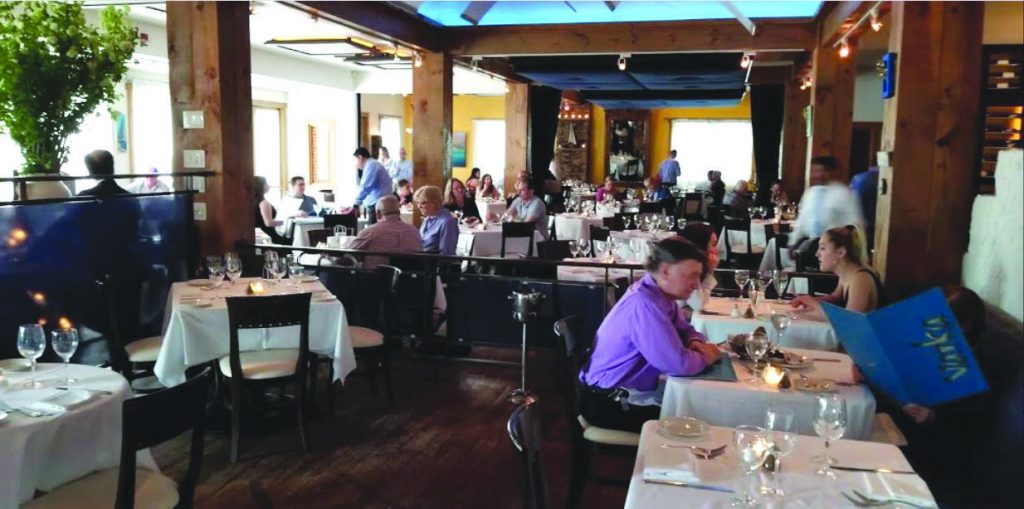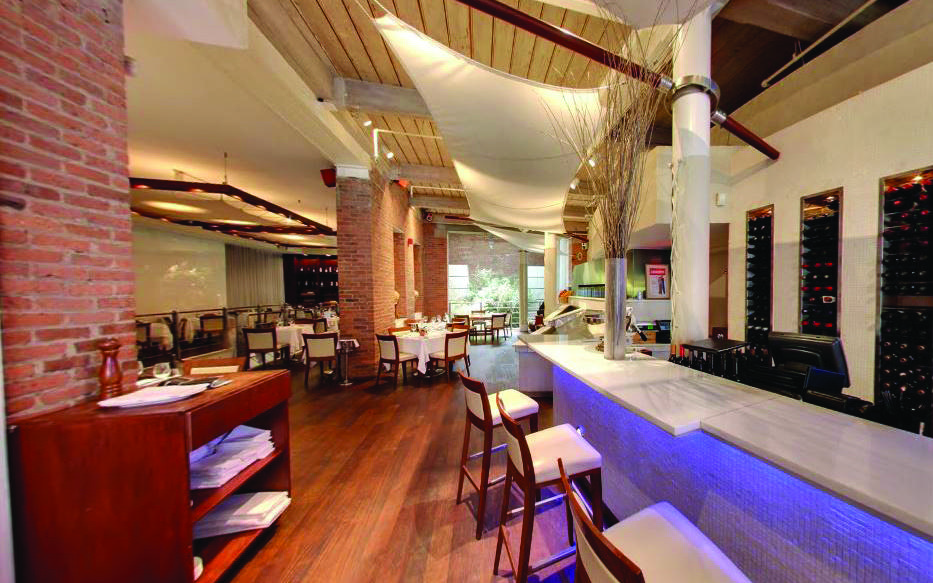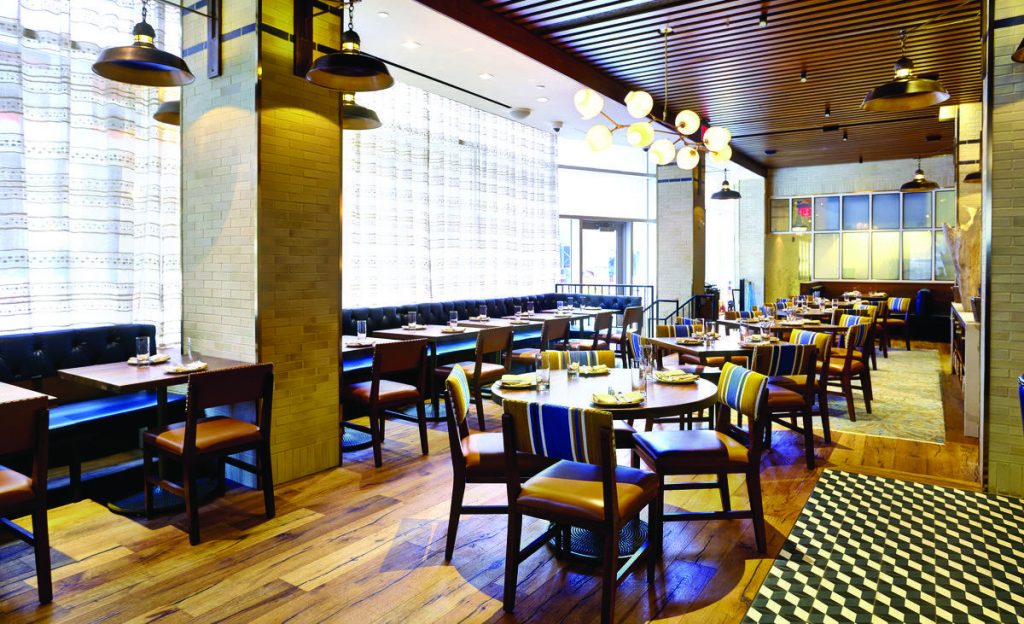So, You Want to Open a Greek Restaurant?
Posted by estiator at 5 October, at 08 : 31 AM Print
By Constantine N. Kolitsas

Varka Estiatorio, Ramsey, NJ, owned by Peter Mastorakos and family
AMERICANS, first introduced to Greek cuisine at local diners, pizzerias and church festivals, are now learning about traditional Greek cooking, and the health benefits that come with it as the “Mediterranean Diet” movement picks up steam. Let’s be honest with one another – the Greek food we’ve been serving from our diners and family restaurants is not the same as the food we serve in our homes or the food we enjoy at our family tables when we go back to visit the “old country”. The food we’ve served in our restaurants over the years that we call “Greek” has, in large part, been Americanized or commercialized. Hard-to-find authentic ingredients aren’t commonly used in our restaurants – they are saved for our home meals. And it’s not cost-effective to use the best ingredients when we are pressured to contain costs.
And so we compromise. And we compromise and we compromise: We freeze to keep things on the menu that don’t sell quickly enough. We add sauces that are not traditional because we need to prevent things from drying when we reheat (how many mousakas have you seen drowned in tomato sauce?). We add lettuce to Greek salad because until recently Americans didn’t consider anything a salad that didn’t sit on a mountain of greens. And we compromise and we compromise. And we cut corners so that we can produce the stuff profitably.
Now, let’s also take into account that most of the restaurants we operate are mid-priced or family friendly. For the most part, they’re not upscale, high-end eateries, especially those that have been in the family for a generation or two. Most of us operate restaurants that have a wide appeal with the goal of generating high volume traffic and adhere to the old adage that the masses flock to where the cost is low. How many diners are serving Dodonis feta on their Greek salads and how many are selling the cheaper Bulgarian substitute (of course we lie to ourselves, convincing ourselves that it’s just as good when it’s a world away from the real thing). As such, the wonderful Greek food that we know, with its authentic and fresh ingredients, has in many ways been kept secret from the general American restaurant-going public. And when we spoke about Greek food, the picture that popped into a non-Greek’s mind was of the gyro strips that were slapped on the grill at the local diner and stuffed inside of a pita wrap with tzatziki made from sour cream rather than rich, thick Greek yogurt.
«It is redemption time for Greek cuisine»
The first real challenges to the American notion of Greek cooking came in the 1990s as New York City became home to a handful of Greek eateries that perched in the Great American Gastropolis. Restaurants like Steve Tzolis’s Periyiali in Chelsea, the since-shuttered Gus’s Place in Greenwhich Village, Avra (now grown to two Manhattan locations), the Livanos family’s Molyvos and the first American extension of Montreal restaurateur Costas Spiliadis’s Estiatorio Milos helped to reimagine Greek cuisine in the consciousness of trend-setting New Yorkers. By the next decade, Manhattanites were crossing the river to invade Astoria’s restaurants (traditionally destinations for the neighborhood’s large Greek population as well as a Mecca for Greeks in the suburbs) to satiate their palate and their 14 curiosity as regards Greek cuisine. Soon, the Greek fish houses became the most highly-regarded of the city’s seafood destinations, with a dinner for two at Estiatorio Milos costing as much as a car payment on a small vehicle. The success of those trailblazing restaurants attracted other Greek restaurateurs into the fine dining space whose approach was authenticity or creative upscale cuisine rooted in Greek flavors and techniques.
Today, some of Manhattan’s most popular restaurants have Greek names such as Kellari, Yefsi, Kyma, Molyvos and the eponymously named Loi Estiatorio, owned and operated by the doyenne of Greek gastronomy, Maria Loi. And the movement is expanding: Just across the Hudson river, Varka Estiatorio, in Ramsey, New Jersey, has redefined the suburban understanding of a great seafood restaurant.
Riding the wave of the Greek yogurt craze and following news accounts that identify the Greek island of Ikaria as “the island where people forget to die”, dieticians, researchers and food journalists have jumped on the bandwagon, heralding the Mediterranean diet as among the world’s healthiest and most flavor-filled.
Even the fast casual segment has joined the party. Once derided as unhealthy and undesirable, fast food in the United States has evolved into two groups – one that stays on the cheap track (think Taco Bell, KFC, and all of the other long-established burger brands), and another that is looking to provide health- and quality-conscious Americans with a fast alternative. On that track, you have several Greek-themed brands such as the Chipotle-inspired Simple Greek (started by CNBC’s reality star Marcus Lemonis from The Profit), Zoe’s Kitchen, Taziki’s, Cava and Daphne’s that are staking out national recognition while small mom-and-pop upstarts throughout the country, like Gyro-on-Pita in the tony village of Ridgefield, Connecticut, are winning over fans ahead of the franchise onslaught that is certain to take place.

Thalassa Restaurant, in Tribeca, NY, owned by the George Makris family
And so, there is a perfect storm that has developed that seems to call out to any Greek in the foodservice industry to capitalize on the trend.
But there is a danger to this. Without knowledge of the fast casual franchise world, there is easily a ten-year learning curve that start-ups need to go through to be competitive on a regional scale, let alone a national one. And on the fine dining/casual upscale side of the business, we tend to fall into traps that expose our business origins as high-volume restaurant/diner operators, and spell doom. And along with our own business, we chance damaging the reputation that Greek cuisine has been building (in spite of us) over the last decade.
This said, Greek restaurant operators are still the natural group to capitalize on public’s infatuation with the Greek diet and Greek cuisine; an infatuation that, if not maligned by well-intentioned but unqualified operators, could (rightfully and righteously) displace some of the most ubiquitous ethnic food categories. But there are some things to be cautious of so that your new upscale Greek restaurant delivers on the high expectation that American restaurant-goers have developed through their business travels to the big cities like New York, Boston, Washington and Chicago, as well as to Greece itself, which has gone through a phenomenal restaurant renaissance over the last ten years (in spite of the economic crisis that has plagued the nation).
AMBIENCE
In the old days, Greek restaurateurs decorated their eateries with large colorful murals, Ionian-style columns, tourist photos of their home island, and Greek flags. The décor was an expression of their love for their homeland. Unfortunately, for many of us, the old days never left.
The first step in designing an upscale Greek restaurant, then, is to avoid the kitschy representations of Greece and its cuisine. Not everything needs to be blue-and-white. In fact, one of the best examples of contemporary Greek cuisine, Committee Ouzeri + Bar in Boston, hasn’t got a spec of blue. Instead, the space is laid out in distressed wood slats, brick walls, a cement floor, industrial-inspired lighting and leather sofas. The décor’s natural textures reflect the food’s natural and wholesome ingredients. The unlikely choice of the name “Committee” also seems to wink at the fact that this is not your father’s Greek restaurant, but a Greek restaurant that is tuned in to the city’s vibe.
MENU
We Greek Americans tend to overload our menus, confusing our guests and creating inefficiencies in our production, inventories, labor models and food cost. Upscale restaurant-goers today are not looking for a restaurant to be able to serve any culinary whim that they may be experiencing at the moment, but, rather, to experience a chef’s vision and expression of his or her culinary point of view. They are also focused on the ingredients, looking for locally-produced, sustainable and fresh products devoid of the toxins we are typically finding in goods procured from mass-produced farms and large-scale manufacturers.
As such, a menu at an upscale restaurant will have only about fifteen or twenty entrees.
And as for the recipe’s themselves, yia yia may have made the best soutzoukakia, but that doesn’t mean they should be reproduced on your menu. While some of these family recipes are a homerun, there are just as many that are strike-outs. At the end of the day, it’s best to get professional help that can create your menu and train your staff to execute, whether that help is a permanent chef to lead your team or, as in the case of some very high-profile restaurants, a consulting chef that has a proven track record. The Livanos Restaurant Group (which owns and operates the recently-opened Manhattan eatery Ousia as well as non-Greek notables Oceana, City Limits and Moderne Barn) did just this, bringing in celeb chef Diane Kochilas, an expat Greek American living in Greece, to create the recipes for its storied Molyvos. Kochilas, whose cookbooks have helped promote Greek cuisine for two decades, is the host of TV’s My Greek Table.
PRESENTATION
As the internet has for many become a repository for recipes, restaurant reviews and food photos, the idea of “food porn” is more than a comical commentary on the salaciousness of a tasty bite; it sets an expectation as to how food should look. Even food served at dinner parties in private homes is being presented in ways that are camera-loving and fashion-minded. So much more, then, is food plated at your restaurant. At upscale restaurants, the expectation is even higher, so you’ve got to make sure that your plates are works of art, worthy to be posted on social media where it will be judged by its cover, so to speak.

Ousia, of the Livanos Group, is a recent addition to the Greek restaurant scene in Manhattan. Located on the waterfront, just off the West Side Highway and offers shared plates, craft beer and signature cocktails with Mediterranean influences.
INTERPRETATION
Greek cuisine is not only about traditional recipes handed down from generation to generation, but about contemporary interpretations of traditional food, as well as about new creations inspired by the ingredients of the Greek bounty as well as the techniques of the Greek kitchen. Committee Ouzeri + Bar in Boston is a perfect example of this, where moussaka eschews the commonly utilized eggplant for artichoke to pair with its caramelized onions, potato and béchamel; halloumi is served with a thick slice of ruby red grapefruit, a sprig of fresh mint and doused in a shot of mastiha liqueur; and a supple, smooth cheesecake is topped with a piece of deconstructed baklava and drizzled in Greek honey.
THE EXPERIENCE
Upscale restaurants are not just about filling your belly, but about an experience. Tapas, the Spanish term for small appetizers, is a fast-growing trend that is being applied across the ethnic spectrum (we Greeks know them as “mezedhes”). The ability of a restaurant to be creative not just in the food served, but in how its customers eat that food, helps that experience. Family portions, un-coursed small plates, shareables and customization are just a few ways that the experience can be re-shaped.
CONCIDER THE SOURCE
The key to delicious Greek food is the quality of the ingredients used. Fortunately, Greek producers have been growing their presence in the United States, making available superb small-farm boutique cheeses, oils, honeys, wines and (among many others) olives to American restaurants through a growing network of distribution channels. In the upscale world, it’s critical to get a higher quality product and charge a few dollars more than to skimp and use inferior ingredients that will detract from the quality of your food. (In fact, wherever Greek food is sold – in diners, pizza restaurants or fast casual joints – quality ingredients yield the best results, but this for another cover story.)
WHO ARE YOU?
At the end of the day, a successful upscale Greek restaurant will reflect an owner/operator who has a respect for the customer’s culinary intellect; has an appreciation for creativity and beautiful food; understands authentic Greek cuisine; adheres to a commitment to quality; has a great eye for design; possesses a true passion for hospitality that is at the core of our Greek character; and is tuned in to the vibe of the community and can reflect and expand on that vibe within his or her restaurant’s walls.
Constantine Kolitsas is a restaurant consultant working in the NYNJ-CT tri-state area. He can be reached at ckolitsas@gmail.com.














